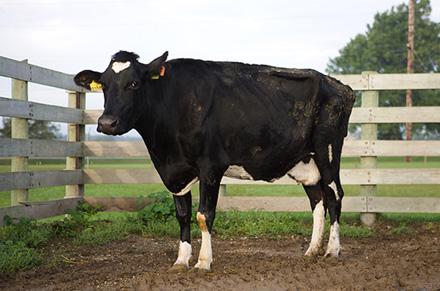Johne’s Disease Research Reveals Promise

A cow in the late stages of disease and has typical clinical signs such as weight loss, watery diarrhea, and general poor health. (Photo by Peggy Greb, d1441-1)
For decades, dairy cow farmers have been dealing with a serious disease that can affect cattle within their herds. Johne’s disease can be debilitating and fatal in cattle and other ruminant animals (hoofed mammals with multiple stomachs, including a rumen), such as sheep, goats, and deer.
There is no cure for Johne’s disease (pronounced “yo-knees”), but scientists at the Agricultural Research Service’s (ARS) National Animal Disease Center (NADC) in Ames, IA, are investigating both high-tech and natural elements to fight it, and have come up with promising treatment options.
Johne’s is a long-lasting, chronic disease that causes inflammation of the small intestine. The inflammation thickens the intestine and prevents nutrient absorption, which is a primary function of the healthy intestine. As a result, the animal eats, but still loses weight due to lack of nutrient absorption.
Researchers at NADC are using both genomic and proteomic technologies to combat the disease. Genomic research examines the DNA, while proteomics is the study of the interactions, function, composition, and structures of proteins and their cellular activities.
One promising treatment option is a vaccine cocktail made up of four proteins from the bacterium that causes the disease, Mycobacterium avium subsp. Paratuberculosis (MAP). A 12-month follow-up study showed the vaccine lowered the MAP burden in the body tissues and lessened shedding of the bacteria.
“The lower shedding is particularly important as it may be enough to break the transmission cycle of this contagious disease,” said John Bannantine, microbiologist at NADC.
Another, potentially simpler, therapeutic treatment is a nutritional supplement: vitamin D. “One thing we noted early on is that vitamin D is lacking in cows with this disease when compared to healthy animals,” said John Bannantine, microbiologist at NADC.
“Vitamin D can vary the strength of both pro- and anti-inflammatory immune responses in dairy cattle infected with MAP,” he said. “It does so by decreasing bacterial viability when they are inside macrophages.” Macrophages are cells that surround and kill the bacteria.
In short, Bannantine said that vitamin D could well have a therapeutic effect for Johne’s disease, but more work must be done.
Johne’s has devastating economic consequences for the dairy industry. The disease is endemic to the United States and, worldwide, Johne’s also has trade implications. The disease can affect beef cattle herds, but it is mainly found in dairy operations. The National Center for Biotechnology Information says annual losses from Johne’s can reach up to $500 million in the United States alone.
The disease spreads in three ways: by an infected cow passing the organism to an unborn fetus, by calves nursing an infected cow, and by cattle coming into contact with bacteria-laden manure. The primary Johne’s control method is removing infected animals from the herd, so early detection of the disease is critical. Fortunately, scientists at NADC have also created a diagnostic tool that detects Johne’s.
“We have gotten to the point where we can begin to understand transmission dynamics,” Bannantine said. “This achievement [will] enable tracking of the bacterial strains. Now, we can get a clearer picture of how the bacteria moves on farms and within regions to break transmission points.” – by Scott Elliott, ARS Office of Communications
Also in our series on cattle:

